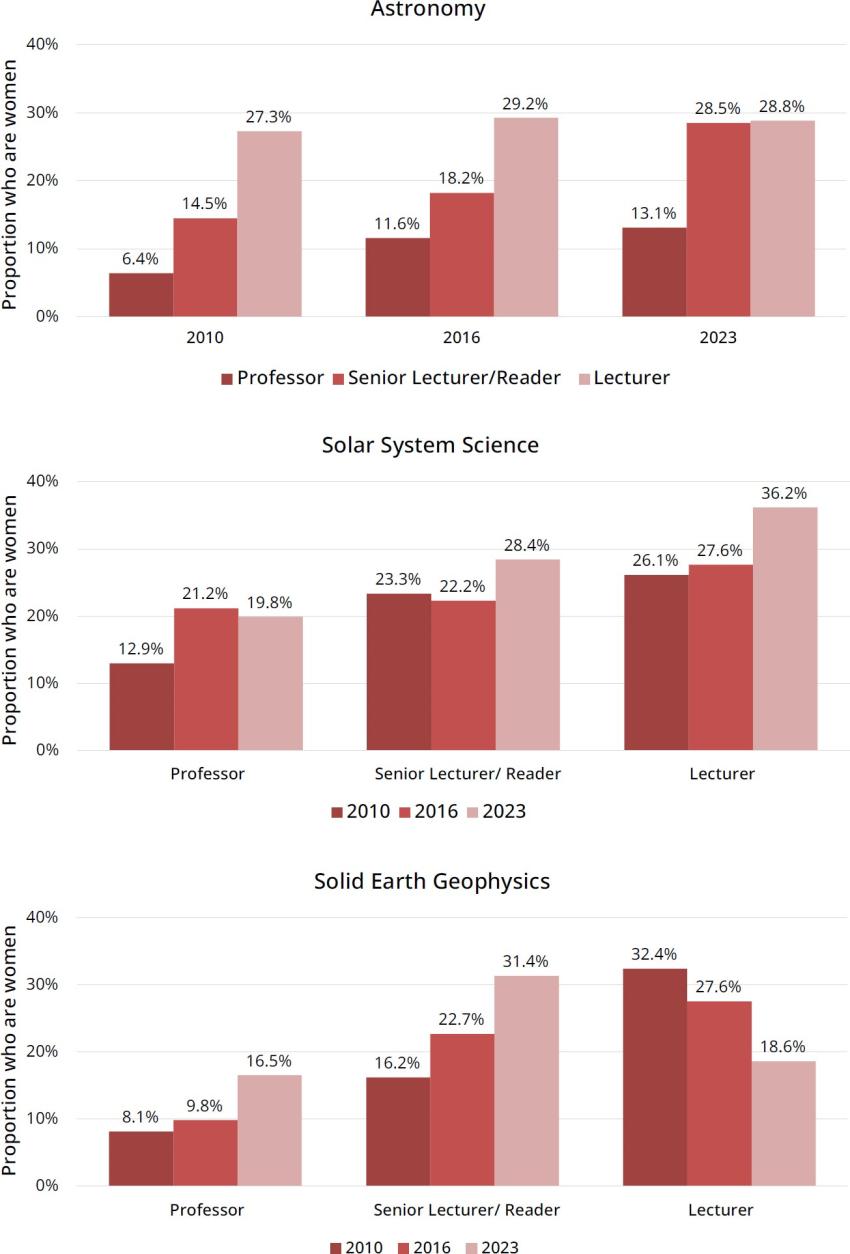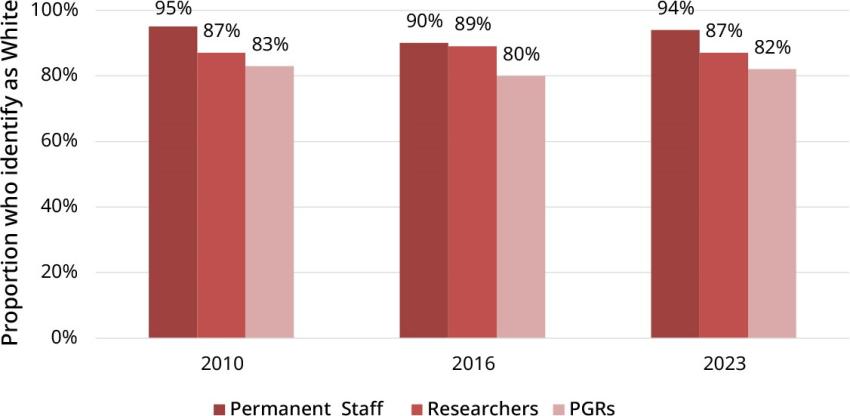Women and ethnic minority groups are still significantly underrepresented in astronomy and geophysics despite attempts to bring about change over the past decade, research has shown.
The survey, carried out by the Royal Astronomical Society and presented at the National Astronomy Meeting 2025 in Durham, found that "decades of initiatives to improve representation" have failed.
"Practitioners of astronomy and geophysics are still overwhelmingly white men," the survey carried out in 2023 revealed, "and the proportion of women in our sciences remains stubbornly low".
RAS President Professor Mike Lockwood said: "One only has to look at the history of science and mathematics to understand that talent can, has, and does come from absolutely anywhere in society, and our concern is that astronomy and geophysics in the UK is missing out on some of the best natural talent available to us.
"Until we live in a perfect meritocracy, this loss of talent will always happen – our job is to try to minimise it.
"We must use these statistics to shape our policies and strategy to ensure that our sciences allow individuals to realise their full potential."
Among permanent staff, 97 per cent of British respondents to the questionnaire across astronomy and geophysics were white, up from 95 per cent in 2016. For comparison, combining the 2021 censuses for England and Wales and Northern Ireland and the 2022 census for Scotland indicates that 83 per cent of the population across those nations was white.
Ethnic representation among postgraduate students is also very different from the wider UK population. The survey data indicate that, in 2023, 70 per cent of respondents were British, and of that group 92 per cent were white, an increase of 5 per cent since 2016.
For comparison, separate UCAS data purchased by the Society show that in 2022 around 83 per cent of places on 'astronomy' undergraduate courses (including those in areas such as planetary science, but not those covered by broader natural science programmes) were accepted by white applicants, and 80 per cent for geophysics programmes.
"Overall, astronomy and geophysics remain fields with significant under-representation of ethnic minority groups," the survey concluded.
The research also showed that the proportions of women professors and senior lecturers/readers increased from 2010 to 2023 in astronomy and solar system science, but among lecturers, levels were flat in astronomy after 2016. In solid-Earth geophysics the proportion in lecturer roles decreased after 2016 to 19 per cent.
Representation of women is higher among postdoctoral researchers than it is among permanent academic staff, at 28 per cent in astronomy, 28 per cent in solar system science and 34 per cent in solid-Earth geophysics.
Non-binary respondents made up 3 per cent of permanent staff and 1 per cent of postdoctoral researchers, along with 7 per cent of astronomy and 5 per cent of geophysics postgraduate students (a single respondent).
"The proportion of women in our sciences remains stubbornly low," the survey concluded.
Sexual orientation was the only area in the survey data where the academic community in astronomy and geophysics was found to be more diverse than the wider society.
Of those who gave their sexual orientation, 93 per cent of permanent staff and 83 per cent of postdoctoral researchers stated that they were heterosexual/straight (a fall of 2 per cent and 8 per cent since 2016). This is lower than the 97 per cent of those responding to the 2021 Census of England and Wales.
Of both permanent staff and postdoctoral researchers, 3 per cent described themselves as gay or lesbian, and 3 per cent and 14 per cent, respectively, as bisexual.
Among postdocs, there were significant differences between genders, with 24 per cent of women stating they were bisexual, compared with 4 per cent of men. For comparison, census data for 2021 (for England and Wales) suggest around 3 per cent of the women and 2 per cent of men in the population aged 25 to 34 are bisexual.
The RAS takes part in bodies such as the LGBT+ Physical Sciences Network, and supports the efforts by that group to assess workplace culture.
Dr Robert Massey, deputy executive director of the Royal Astronomical Society, said: "As children we all wonder about the planet we live on, other worlds and the wider universe. That undoubtedly helped many of us pursue careers in science, and everyone should be able to make that choice regardless of their background.
"I very much want to see far more women and people from minority ethnic groups working as astronomers and geophysicists, and we have to redouble our efforts to make that happen."
The survey concluded that "in short, after decades of initiatives to improve representation, the numbers of women even entering physics, astronomy and geophysics undergraduate courses remain low" and astronomy and geophysics are still "overwhelmingly white".
ENDS
Media contacts
Sam Tonkin
Royal Astronomical Society
Mob: +44 (0)7802 877 700
Dr Robert Massey
Royal Astronomical Society
Mob: +44 (0)7802 877 699
Megan Eaves
Royal Astronomical Society
Images & captions
Caption: Numbers of staff and postgraduate students in astronomy, solar system science and geophysics in the 2023, 2016 and 2010 surveys.
Credit: Royal Astronomical Society
Caption: Proportion of academic staff who are women in universities by grade and broad research area.
Credit: Royal Astronomical Society
Caption: Proportions of individual questionnaire respondents who identified as white.
Credit: Royal Astronomical Society
RAS demographics - sexual orientation
Caption: Sexual orientations of postgraduate student questionnaire respondents by gender, 2023.
Credit: Royal Astronomical Society
Further information
The talk 'RAS Demographics and Research Interests Survey' took place at NAM at 09:05 BST on Thursday 10 July 2025. Find out more at: https://conference.astro.dur.ac.uk/event/7/contributions/488/
In order to explore how the fields of astronomy and geophysics are changing, the Royal Astronomical Society has undertaken surveys since 1993.
The most recent collected data in 2023. It indicated the highest number yet of people working as astronomers and solar system scientists in the UK, with a substantial increase in numbers since 2016; at the same time, the solid-Earth geophysics community has become smaller.
The 2023 survey took place around the time that the World Health Organisation declared an end to Covid-19 as a public health emergency, and about two-and-a-half years after the Brexit transition period finished. It also offers a baseline dataset before the election of the Labour government in July 2024, which may mark the beginning of a scientific renaissance, or a transition to more difficult times.
Notes for editors
The NAM 2025 conference is principally sponsored by the Royal Astronomical Society and Durham University.
About the Royal Astronomical Society
The Royal Astronomical Society (RAS), founded in 1820, encourages and promotes the study of astronomy, solar-system science, geophysics and closely related branches of science.
The RAS organises scientific meetings, publishes international research and review journals, recognises outstanding achievements by the award of medals and prizes, maintains an extensive library, supports education through grants and outreach activities and represents UK astronomy nationally and internationally. Its more than 4,000 members (Fellows), a third based overseas, include scientific researchers in universities, observatories and laboratories as well as historians of astronomy and others.
The RAS accepts papers for its journals based on the principle of peer review, in which fellow experts on the editorial boards accept the paper as worth considering. The Society issues press releases based on a similar principle, but the organisations and scientists concerned have overall responsibility for their content.
Keep up with the RAS on Instagram, Bluesky, LinkedIn, Facebook and YouTube.
Download the RAS Supermassive podcast
About the Science and Technology Facilities Council
The Science and Technology Facilities Council (STFC), part of UK Research and Innovation (UKRI), is the UK’s largest public funder of research into astronomy and astrophysics, particle and nuclear physics, and space science. We operate five national laboratories across the UK which, supported by a network of additional research facilities, increase our understanding of the world around us and develop innovative technologies in response to pressing scientific and societal issues. We also facilitate UK involvement in a number of international research activities including the ELT, CERN, the James Webb Space Telescope and the Square Kilometre Array Observatory.
About Durham University
Durham University is a globally outstanding centre of teaching and research based in historic Durham City in the UK.
We are a collegiate university committed to inspiring our people to do outstanding things at Durham and in the world.
We conduct research that improves lives globally and we are ranked as a world top 100 university with an international reputation in research and education (QS World University Rankings 2026).
We are a member of the Russell Group of leading research-intensive UK universities and we are consistently ranked as a top five university in national league tables (Times and Sunday Times Good University Guide and The Complete University Guide).
For more information about Durham University visit: www.durham.ac.uk/about/





